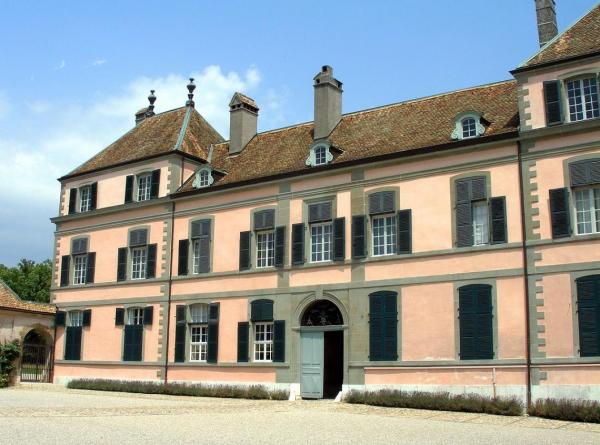The castle of the family Necker-De Staêl and the Groupe de Coppet in Coppet (Switzerland)
“Maybe one day will come, gentlemen, when […] you will throw a glance of compassion on this unfortunate people which has been quietly a barbaric object of trafficking; on those men who are like us in thought, and especially in the sad faculty of suffering; on these men, however, that, without pity for their painful complaints, we accumulate, we pile up at the bottom of a ship, to then go under full sail and present them to the chains that await them.”
Jacques Necker, minister of Louis XVI at the States General of the Kingdom on 5 May 1789

The castle of the family Necker-De Staël in Coppet, Switzerland
The anti-slavery commitment was one of the fights of the thinkers of the Groupe de Coppet, which began with Jacques Necker, minister of Louis XVI, and continued through his daughter, Germaine de Staël and his grandson, Auguste de Staël, joined by Benjamin Constant and Jean-Léonard Sismondi. From 1789 to 1830, they relentless fought for the abolition of the slave trade and slavery.
It is Jacques Necker (1732-1804), born in Geneva, then minister of Louis XVI, who started a long family fight by eloquently denouncing the misdeeds of a trade that still hurts the contemporary conscience, in the speech he made on the occasion of the Estates General, on 5 May 1789 in Versailles:
“Maybe one day will come, gentlemen, when […] you will throw a glance of compassion on this unfortunate people which has been quietly a barbaric object of trafficking; on those men who are like us in thought, and especially in the sad faculty of suffering; on these men, however, that, without pity for their painful complaints, we accumulate, we pile up at the bottom of a ship, to then go under full sail and present them to the chains that await them.”
In the wake of her father, Madame de Staël (1766-1817) tried to condemn the slave trade on many occasions, in accordance with her ideal of justice and Christian charity. She even showed a strong empathy towards the slaves, their “terrible yoke”, and contributed greatly to the abolitionist struggle. In her short stories, she deeply called into question the stereotypes associated with race. She defended free trade and the development of the African economy, so that liberated trade could expand globally, a resolutely forward-looking vision that has not yet been realized.

Portrait of Germaine de Staël
Germaine de Staël, and the Groupe de Coppet asked the European rulers, meeting in Paris in 1814, to abolish the slave trade.
Her son Auguste de Staël (1790-1827) took up the cause on his own, but in the form of a philanthropic mission: he was an influential activist of the abolitionist movement, inspired by the British parliamentarian William Wilberforce, admired and praised by his mother, one of the leaders against slavery in Britain.
In 1822, he founded the Committee for the Abolition of the Black Trade within the Society of Christian Morality. The objectives were to suppress trafficking and improve the “fate of blacks in various parts of the world” and whose activism led to the prohibition of trafficking in 1831. He published extensively on the subject and promoted gradual emancipation through education. He organized petitions to put pressure on the government. He even went so far as to document the horrors of the slave trade by resorting to perilous investigations: he brought back chains and necklaces from a stay in Nantes as evidence of the cruelty of a traffic that still prevailed despite formal prohibitions. He exhibited the objects in Paris, which produced more effect than many vehement declamations.
Following the footsteps of his grandfather and mother, Auguste de Staël did not appear to be a theorist, but a man of the field and networks, who nevertheless cultivated a devotion to high ideas. He combined principles and morality with a tactical intelligence and a sense of priority that would make his action extraordinarily effective for the time.
This three-generation family tradition is blended with the achievements of Benjamin Constant (1867-1830), born in Lausanne, who protested against slavery through legislation: he did a dozen of interventions; he did not hesitate to criticise the government. He regularly published on the subject in his newspaper, La Minerve.
He especially sets out his views in detail in his Commentaire sur l’ouvrage de Filangieri, where he defends the equality in law and the parity of crimes and expects a public condemnation of the practices in question: “When this truth will be well recognized; when the laws will not differentiate between at least equal crimes; when, independently of the laws, the indignant opinion will pursue in the streets and on public places the trader who will have taken part in the trafficking, almost the entire trading population will refuse to be soaked in them.”
In June 1820, Benjamin Constant called for a “strong” law at the platform of the Chamber of Deputies. “We must hasten to establish a strong, effective and sufficient law against the appalling slave trade. Ours are not […]. Trafficking is done: it is done with impunity. We know the date of departures, purchases, arrivals.”
He underlined the difficulty of passing laws against the convictions of the time: “The opinion in this respect was prepared in England by long discussions and by the tireless perseverance of the most respected men”, observed Constant. “Therefore, we must work tirelessly on the production of this moral conviction.” Constant did not hesitate to use strong images to do so, commensurate with the crimes and devastating consequences on governance in Africa that he denounced.
In addition to this moral approach, the economic dimension is addressed by Jean Léonard Sismondi (1773-1842), born in Geneva, an economist associated with the Groupe de Coppet, who systematically elucidates this question: he shows the perversity of the slave system, in the sense that the slave trade does not create wealth, but is similar to looting; it has only been able to survive through legal privileges, through monopoly, maintaining archaic forms of production that could not have been sustained under a system of free competition. The very low labour productivity would even make slave trade very expensive.







